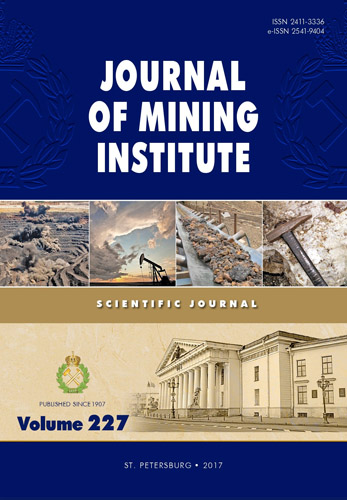On osmondite nature
- 1 — Ph.D. associate professor Saint-Petersburg Mining University
- 2 — Ph.D. Lead designer Geotechnical Engineers and Scientists
Abstract
The uniqueness of iron is not only that it is one of the most common elements, and the production of its derivative (steel) «exceeds the production of other metals by 14 times», not only in its polymorphism, but also in the following: «conversion of BCC α-Fe (К = 8) into a denser FCC γ-modification (K = 12) with heating is quite unusual and along with the thermodynamic interpretation requires a special physical explanation, especially in connection with the fact that it lies at the basis of the metal science and the thermal treatment of iron alloys» ( V.K.Grigorovich). «Unusual» iron is also confirmed by the fact that the hardness of Fe at 440 °С is 1.15 times higher than at 20 °С. Other metals of this unique quality do not – as the temperature rises, the hardness decreases. Only manganese with a tetragonal lattice exhibits a hardness maximum at 650-750 °C; a maximum hardness is observed near the α D β transformation of manganese. The absolute maximum of hardness at 440 °C for iron allows (by analogy) to assume a transformation in iron at this temperature. Especially note: at the temperature of unconditional a→g → </s> transformation (910 °C) there is an absolute minimum of hardness. A curious situation arose around the temperature interval 400-500 °С. M.V.Belous and his co-authors simply do not notice it in the classification of four transformations during drawing back process, although back in 1925 P.Oberghoffer, basing on a minimum at 400-500 °C of the thermoelectric power of the iron-platinum pair, wrote: «Whether we are here dealing with further transformations in pure iron, should be investigated in new detailed studies». Based on the maximum etchability value, acceleration of the graphitization of steels, the maximum corrosion rate of gray cast iron, anomalies in the temperature dependences of the physical and mechanical properties, changes in the solubility of cementite, the maximum lattice parameter, the extremum on the resistance curve of the pure iron deposit, the conversion in iron at ~ 450 °C is justified.
References
- Belous M.V., Cherepin V.T., Vasil'ev M.A.Transformations during steel drawing back. Мoscow: Metallurgija, 1973, p. 232.
- Grigorovich V.K.Electronic structure and thermodynamics of iron alloys.Мoscow: Nauka, 1970, p. 292 (in Russian).
- Gridnev V.N., Petrov Ju.N. Electron-microscopic study of the structure of electrically released steel. Voprosy fiziki metallov i metallovedenija. 1964. N 19, p. 79-86 (in Russian).
- Gudremon Je. Special steels. In 2 volumes. Vol. 1. Мoscow: Metallurgizdat, 1959, p. 952 (in Russian).
- Kurdjumov G.V., Utevskij L.M., Jentin R.I. Transformation of iron and steel. Мoscow: Nauka, 1970, p. 236 (in Russian).
- Livshic B.G. Physical properties of alloys. Мoscow: Metallurgija, 1946, p. 320 (in Russian).
- Lysak L.I. Change in the fine crystal structure of hardened steel during drawing back. Voprosy fiziki metallov I metallovedenija. 1952. N 3, p. 28-40 (in Russian).
- Schastlivcev V.M., Mirzaev D.A., Jakovleva I.L., Okishev K.Ju., Tabatchikova T.I., Hlebnikova Ju.V. Perlite in carbon steels. Ekaterinburg: UrORAN, 2006, p. 311 (in Russian).
- Starodubov K.F., Babich V.K. Changes of plasticity properties of steel during drawing back. Dnepropetrovsk: UkrNTOChermet, 1957, p. 31 (in Russian).
- Starodubov K.F. On the nature of the processes occurring during tempered steel drawing back at the temperature ranging from 350 to 550С. Nauchn. dokl. vyssh. shkoly. Metallurgija. 1958. N 31, p. 266-268 (in Russian).
- Tavadze F.N., Galinkin B.E. Effect of heat treatment on the corrosion resistance of cast iron.Trudy Gruzinskogo politehnicheskogo in-ta. 1957. N3 (51), p. 120-126 (in Russian).
- Ustinovshhikov Ju.I. Secondary hardening of structural steels.Мoscow: Metallurgija. 1982, p. 128 (in Russian).
- Umanskij Ja.S., Finkel'shtejn B.N., Blanter M.E., Kishkin S.T. Physical metallurgy. Мoscow: Metallurgizdat. 1955, p. 724(in Russian).
- Shahnazarov K.Ju., Shahnazarov A.Ju. 430±30С–nodular (critical) temperature of iron and carbon steel.Metallovedenie i termicheskaja obrabotka metallov. 2001. N 11, p. 24-25 (in Russian).
- Shahnazarov Ju.V., Andreeva V.D. The hardness and width of the X-ray line of carbon and medium alloy steels after drawing back at temperatures of 20-670С. Mat. sem. «Materialovedenie, plasticheskaja i termicheskaja obrabotka»; SPbGPU. St. Pe-tersburg, 2001, p. 34-36 (in Russian).
- Shahnazarov K.Ju. Anomalies of physical and mechanical properties of iron as a consequence of transformations in it at~650, ~450 and~200С. Vestnik Magnitogorskogo gosudarstvennogo tehnicheskogo universiteta im. G.I.Nosova. 2017. Vol.15. N1, p.70-78. DOI: 10.18503/1995-2732-2017-15-1-70-78 (in Russian)
